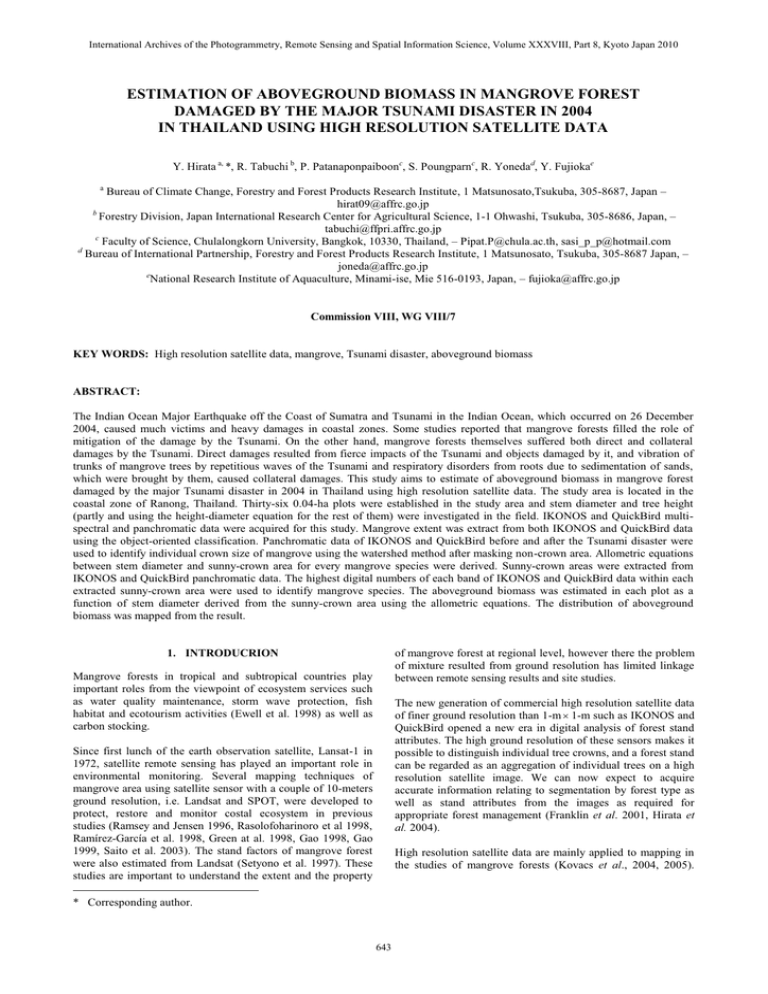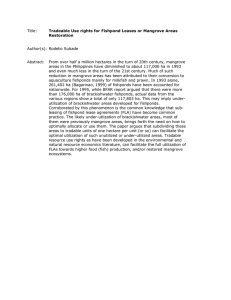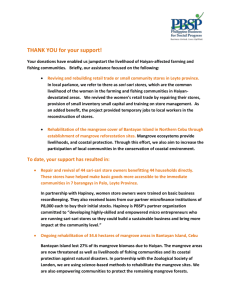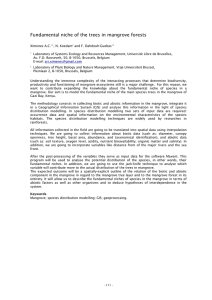ESTIMATION OF ABOVEGROUND BIOMASS IN MANGROVE FOREST
advertisement

International Archives of the Photogrammetry, Remote Sensing and Spatial Information Science, Volume XXXVIII, Part 8, Kyoto Japan 2010 ESTIMATION OF ABOVEGROUND BIOMASS IN MANGROVE FOREST DAMAGED BY THE MAJOR TSUNAMI DISASTER IN 2004 IN THAILAND USING HIGH RESOLUTION SATELLITE DATA Y. Hirata a, *, R. Tabuchi b, P. Patanaponpaiboonc, S. Poungparnc, R. Yonedad, Y. Fujiokae a Bureau of Climate Change, Forestry and Forest Products Research Institute, 1 Matsunosato,Tsukuba, 305-8687, Japan – hirat09@affrc.go.jp b Forestry Division, Japan International Research Center for Agricultural Science, 1-1 Ohwashi, Tsukuba, 305-8686, Japan, – tabuchi@ffpri.affrc.go.jp c Faculty of Science, Chulalongkorn University, Bangkok, 10330, Thailand, – Pipat.P@chula.ac.th, sasi_p_p@hotmail.com d Bureau of International Partnership, Forestry and Forest Products Research Institute, 1 Matsunosato, Tsukuba, 305-8687 Japan, – joneda@affrc.go.jp e National Research Institute of Aquaculture, Minami-ise, Mie 516-0193, Japan, – fujioka@affrc.go.jp Commission VIII, WG VIII/7 KEY WORDS: High resolution satellite data, mangrove, Tsunami disaster, aboveground biomass ABSTRACT: The Indian Ocean Major Earthquake off the Coast of Sumatra and Tsunami in the Indian Ocean, which occurred on 26 December 2004, caused much victims and heavy damages in coastal zones. Some studies reported that mangrove forests filled the role of mitigation of the damage by the Tsunami. On the other hand, mangrove forests themselves suffered both direct and collateral damages by the Tsunami. Direct damages resulted from fierce impacts of the Tsunami and objects damaged by it, and vibration of trunks of mangrove trees by repetitious waves of the Tsunami and respiratory disorders from roots due to sedimentation of sands, which were brought by them, caused collateral damages. This study aims to estimate of aboveground biomass in mangrove forest damaged by the major Tsunami disaster in 2004 in Thailand using high resolution satellite data. The study area is located in the coastal zone of Ranong, Thailand. Thirty-six 0.04-ha plots were established in the study area and stem diameter and tree height (partly and using the height-diameter equation for the rest of them) were investigated in the field. IKONOS and QuickBird multispectral and panchromatic data were acquired for this study. Mangrove extent was extract from both IKONOS and QuickBird data using the object-oriented classification. Panchromatic data of IKONOS and QuickBird before and after the Tsunami disaster were used to identify individual crown size of mangrove using the watershed method after masking non-crown area. Allometric equations between stem diameter and sunny-crown area for every mangrove species were derived. Sunny-crown areas were extracted from IKONOS and QuickBird panchromatic data. The highest digital numbers of each band of IKONOS and QuickBird data within each extracted sunny-crown area were used to identify mangrove species. The aboveground biomass was estimated in each plot as a function of stem diameter derived from the sunny-crown area using the allometric equations. The distribution of aboveground biomass was mapped from the result. of mangrove forest at regional level, however there the problem of mixture resulted from ground resolution has limited linkage between remote sensing results and site studies. 1. INTRODUCRION Mangrove forests in tropical and subtropical countries play important roles from the viewpoint of ecosystem services such as water quality maintenance, storm wave protection, fish habitat and ecotourism activities (Ewell et al. 1998) as well as carbon stocking. The new generation of commercial high resolution satellite data of finer ground resolution than 1-m u 1-m such as IKONOS and QuickBird opened a new era in digital analysis of forest stand attributes. The high ground resolution of these sensors makes it possible to distinguish individual tree crowns, and a forest stand can be regarded as an aggregation of individual trees on a high resolution satellite image. We can now expect to acquire accurate information relating to segmentation by forest type as well as stand attributes from the images as required for appropriate forest management (Franklin et al. 2001, Hirata et al. 2004). Since first lunch of the earth observation satellite, Lansat-1 in 1972, satellite remote sensing has played an important role in environmental monitoring. Several mapping techniques of mangrove area using satellite sensor with a couple of 10-meters ground resolution, i.e. Landsat and SPOT, were developed to protect, restore and monitor costal ecosystem in previous studies (Ramsey and Jensen 1996, Rasolofoharinoro et al 1998, Ramírez-García et al. 1998, Green at al. 1998, Gao 1998, Gao 1999, Saito et al. 2003). The stand factors of mangrove forest were also estimated from Landsat (Setyono et al. 1997). These studies are important to understand the extent and the property High resolution satellite data are mainly applied to mapping in the studies of mangrove forests (Kovacs et al., 2004, 2005). * Corresponding author. 643 International Archives of the Photogrammetry, Remote Sensing and Spatial Information Science, Volume XXXVIII, Part 8, Kyoto Japan 2010 Inventory of mangrove forests is sometimes attended by the difficulty of the access because of the site environment and the complexity of the root system, and aerial photographs for them usually don’t exit except that they have been taken to produce topography maps. Therefore, it is expected that high resolution satellite data are applied to the understanding of the present condition of mangrove forests as well as their dynamics (Rodriguez and Feller, 2004), the classification of tree species using their properties of reflectance (Wang et al., 2004a; Dahdouh-Guebas et al., 2005), and so on. Wang et al. (2004b) indicated that both IKONOS and QuickBird data were suitable for classification of mangrove species from comparison of the results of texture analysis, likelihood classification and objectoriented classification. Estimating biomass and mapping from texture analysis of high resolution satellite data are also tested for mangrove forests (Proisy et al., 2007). The Indian Ocean Major Earthquake off the Coast of Sumatra and Tsunami in the Indian Ocean, which occurred on 26 December 2004, caused much victims and heavy damages in coastal zones. Some studies reported that mangrove forests filled the role of mitigation of the damage by the Tsunami. On the other hand, mangrove forests themselves suffered both direct and collateral damages by the Tsunami. Direct damages resulted from fierce impacts of the Tsunami and objects damaged by it, and vibration of trunks of mangrove trees by repetitious waves of the Tsunami and respiratory disorders from roots due to sedimentation of sands, which were brought by them, caused collateral damages. This study aims to estimate of aboveground biomass in mangrove forest damaged by the major Tsunami disaster in 2004 in Thailand using high resolution satellite data. 2. METHODS 2.1 Study Area and Plot Establishment The study area is located in the coastal zone of Ranong, Thailand. Thirty-six 0.04-ha sample plots were established and stem diameter of all trees and tree height of a part of them were measured in the field (Figure 1). The mean stem diameter of sample plots range from 9.5 to 31.1 cm and the density from 106 to 3700 trees/ha. Dominant species of mangrove are Rhizophora apiculata Bl., Rhizophora mucronata Lamk., Bruguiera cylindrica (L.) Blume, Bruguiera parvifola (Roxb.) Wight et Arnold ex Griffith and Xylocarpus granatum Koenig. Figure 1. Study area and sample plots in Ranong (an extract) using the watershed method for crown segmentation. From the crown diameters, which disappeared during two years after the Tsunami, disappeared tree sizes were estimated using allometric equation between crown size and stem diameter, which is a key variable to estimate individual biomass. Field surveys were conducted after the Tsunami to confirm the damages. 2.2 Satellite Data A reversal image of QuickBird panchromatic data, obtained by subtracting each DN of the original data from the maximum value of DN in the data for each pixel (Wang et al 2004c), was prepared. The watershed method was applied to the reversal image. The mask of non-tree areas was used to avoid overestimating the crown area. Polygons of crowns and a polygon of a sample plot were superimposed and polygons of the inside of crown or partial inside of the plot were extracted. Finally, data sets of crown polygons were prepared for the sample plots. In general, the volume of a tree is estimated from the stem diameter and tree height, while tree height is commonly determined from a height-diameter curve. Therefore, we need to estimate the stem diameter from individual crowns. An allometric model for relating measurable variables is commonly used for forest inventories and ecological studies (Ketterings et al. 2001). This model can be expressed as follows: Panchromatic and multispectral data of IKONOS and QuickBird before and after the Tsunami disaster were acquired before and after the Tsunami. IKONOS data were acquired on 5 June 2003, and QuickBird data were acquired on 15 October 2006. Twenty-four ground control points were prepared in the field using GPS to register satellite images. The data were georegistered to the Universal Transverse Mercator (UTM) coordinate system (WGS 84, zone 47) using the nearest neighbour method for resampling to maintain original reflectance properties. 2.3 Data Analysis The direct damaged areas were extracted from multi-temporal satellite data according to the changes of reflectance property. The collateral damages were evaluated from crown changes derived from multi-temporal QuickBird panchromatic data 644 International Archives of the Photogrammetry, Remote Sensing and Spatial Information Science, Volume XXXVIII, Part 8, Kyoto Japan 2010 E(y) = axb (1) where x is the independent variable, y is the dependent variable and a and b are estimated parameters. Here, we investigated the allometric relationship between crown area obtained from QuickBird panchromatic data and the stem diameter measured in field survey for 23 sample plots. We assumed that segmented crown areas corresponded to stem diameter according to their sizes from the largest tree and suppressed trees could not be observed, i.e., their crowns had no area in the image. Using a data set of the stem diameter and crown area estimated from QuickBird panchromatic data, a and b in Equation (1) for each sample plot were estimated with the least-squares method respectively. Komiyama et al. (1988) investigated the weight of each organ for mangrove species from some sampling trees and introduced formulas as bellows; wS, wB,wPR and wF = a(D2H)b wL = 1/(a/ D2H+b) (2) (3) where, Figure 2. Relationship between basal area and above-ground biomass for sample plots. wS :weight of stem wB :weight of branches wL :weight of leaves wPR :weight of prop roots wF :weight of fruits and a and b are estimated parameters. The weight of each organ by species was estimated from Eq. (2) or (3) using two variables, i.e. stem diameter and tree height with the estimated parameters, while tree height was introduced from diameter-height curve which was obtained from field survey. We calculated aboveground biomass (Ba) of a tree as the sum of these weights. Ba=wS+wB+wL +wPR+wF Above-ground biomass obtained from stem diameter and tree height, which were estimated from QuickBird panchromatic data, are plotted against biomass derived from the field survey in the sample plots. 3. RESULTS AND DISCUSSION Figure 3. Identification of individual crowns from high resolution satellite data in a sample plot 3.1 Above-ground biomass of sample plots From accumulation of biomass of individual trees for sample plots, above-ground biomass of sampling plots were estimated from 91.3 ton/ha to 497.6 ton/ha. Above-ground biomass was strongly related to basal area in mangrove forests (Figure 2, R2=0.94). procedure. We did not measure the reflectance of each mangrove species in the field. Therefore, we could not classify polygons of crowns from the information of reflectance in each band. Instead of it, statistical method was used to identify the species after unsupervised classification. Using ratio of total sunny-crown area of all study plots from canopy surface map, species were assigned to clusters of unsupervised classification. 3.2 Extraction of crown and Identification of species from high resolution satellite data We acquired polygons of sunny-crown that appear on the surface of canopy from high resolution satellite data applying watershed method to its reversal data. Thresholds to remove gap area were decided to 200 by verification of histogram and interpretation of the images. 3.3 Estimation of aboveground biomass The aboveground biomass was calculated from stem diameter obtained from the field survey to evaluate estimation method from high-resolution satellite data. We assigned the highest values of QuickBird multispectral data to the polygons that were generated in the crown extraction 645 International Archives of the Photogrammetry, Remote Sensing and Spatial Information Science, Volume XXXVIII, Part 8, Kyoto Japan 2010 Kovacs, J.M., Flores-Verdugo, F., Wang, J., Aspden, L.P., 2004. Estimating leaf area index of a degraded mangrove forest using high spatial resolution satellite data. Aquatic Botany, 80, pp. 13-22. Kovacs, J.M., Wang, J., and Flores-Verdugo, F., 2005. Mapping mangrove leaf area index at the species level using IKONOS and LAI-2000 sensors for the Agua Brava Lagoon, Mexican Pacific. Estuarine, Coastal and Shelf Science, 62, pp. 377-384. Ramírez-García, P., López-Blanco, Ocaña, D., 1998. Mangrove vegetation assessment in the Santiego River Mouth, Mexico, by means of supervised classification using Landsat TM imagery. Forest Ecology and Management, 105, pp. 217-229. Proisy, C., Couteron, P., and Fromard, F. (2007) Predicting and mapping mangrove biomass from canopy grain analysis using Fourier-based textural ordination of IKONOS images. Remote Sensing of Environment Ramsey E.W., Jensen, J.R., 1996. Remote Sensing of mangrove wetlands: relating canopy spectra to site-specific data. Photogrammetric Engineering & Remote Sensing, 62, 939-948. Rasolofoharinoro, M., Blasco, F., Bellan, M.F., Aizpuru, M., Gauquelin, T. Denis, J., 1998. A remote sensing based methodology for mangrove studies in Madagascar. Int. J. Remote Sensing, 19, 1873-1886. Rodriguez, W. and Feller, I.C. (2004) Mangrove landscape characterization and change in Twin Cays, Belize using aerial photography and IKONOS satellite data. Atoll Research Bulletin 513㧦1-22. Saito, H., Bellan, M.F., Al-Habshi, A., Aizpuru, M., Blasco, F., 2003. Mangrove research and coastal studies with SPOT-4 HRVIR and TERRA ASTER in the Arabian Gulf. Int. J. Remote Sensing, 24, 4073-4092. Setyono, D., Sato, K., Kohda, Y., 1997. Relationships between calculated indexes from TM data of Landsat 5 and stand parameters on mangrove forest in Okinawa. J. Jpn Soc. Photogrammetry and Remote Sensing, 36(3), 6-12. (in Japanese with English abstract) Wang, L., Sousa, W.P. and Gong, P. 2004a. Integration of object-based and pixel-based classification for mapping mangroves with IKONOS imagery. Int. J. Remote Sens. 25: 5655-5668. Wang, L., Soura, W.P., Gong, P. and Biging, G.S. 2004b. Comparison of IKONOS and QuickBird images for mapping mangrove species on the Caribbean coast of Panama. Remote Sens. Environ. 91:432-440. Wang, L., Gong, P. and Biging, S. 2004c. Individual tree-crown delineation and treetop detection in high-resolution aerial imagery. PE & RS 70:351-357. Form the comparison of above-ground biomass before and after the Tsunami, it was found that about 1 % of the biomass in the entire study area were lost by the Tsunami disaster. The distribution of aboveground biomass was mapped from the result. 4. CONCLUSIONS The accuracy of the biomass estimation seems to depend on the amount of the suppressed trees. Indeed, tree numbers of study plots, which were extracted from the QuickBird data respectively, were smaller than real tree numbers. Particularly, if trees of second layer are hidden by canopy layer, uncounted biomass occupy quit large part of estimation. Here, we used the watershed method to identify crown area. This is one of most common method for this purpose; however, we should recognize that crown conditions are obviously different by individual trees. Some large trees are regards as multiple trees because of some divided crowns. When canopy surface is comparatively flat, canopy is not divided suitably for the limitation of the method. Nevertheless these problems, the results indicated the possibility of utilization of high-resolution satellite data to estimate the above-ground biomass of mangrove forest. REFERENCES Dahdouh-Guebas, F., Hiel, E.V., Chen, J.C.-W., Jayatissa, L.P. and Koedam, N., 2005. Qualitative distinction of congeneric and introgressive mangrove species in mixed patchy forest assemblages using high spatial resolution remotely sensed imagery (IKONOS). Systematics and Biodiversity, 2, pp. 113119. Ewell, K.C., Ong, J.E., Twilley, R.R., 1998. Different kinds of mangrove swamps provide different goods and services. Ecology and Biogeography Letters, 7, pp. 83-94. Franklin, S.E., Wulder, M.A., Gerylo, G.R., 2001. Texture analysis of IKONOS panchromatic data for Douglas-fir forest age class separability in British Columbia. International Journal of Remote Sensing, 22(1), pp. 1-5. Gao, J., 1998. A hybrid method toward accurate mapping mangroves in a marginal babitat from SPOT multispectral data. International Journal of Remote Sensing, 19, pp. 1887-1899. Gao, J., 1999. A comparative study on spatial and spectral resolutions of satellite data in mapping mangrove forests. International Journal of Remote Sensing, 20, pp. 2823-2833. Green, E.P., Clark, C.D., Munby P.J., Edwards A.J., Ellis, A.C., 1998. Remote Sensing thechniques for mangrove mapping. International Journal of Remote Sensing, 19, pp. 935-956. Hirata Y, Sato K, Kuramoto S, Sakai A., 2004. Extracting forest patch attributes at the Landscape level using new remote sensing techniques – An integrated approach of high-resolution satellite data, lidar data and GIS data for forest conservation. In Marchetti M (ed.) Monitoring and Indicators of Forest Biodiversity in Europe – From Ideas to Operationalty. European Forest Institute, Saarijärvi, pp. 359-367. Ketterings, Q.M., Coe, R., van Noordwijk, M., Ambagau, Y. and Palm, C.A., 2001. Reducing uncertainty in the use of allometric biomass equations for predicting above-ground tree biomass in mixed secondary forests. Forest Ecology and Management, 146, pp. 199-209. Komiyama, A., Jintana, V., Sangtiean, T., Kato, S., 2002. A common allometric equation for predicting stem weight of mangroves growing in secondary forests. Ecological Research, 17, pp. 415-418. 646





